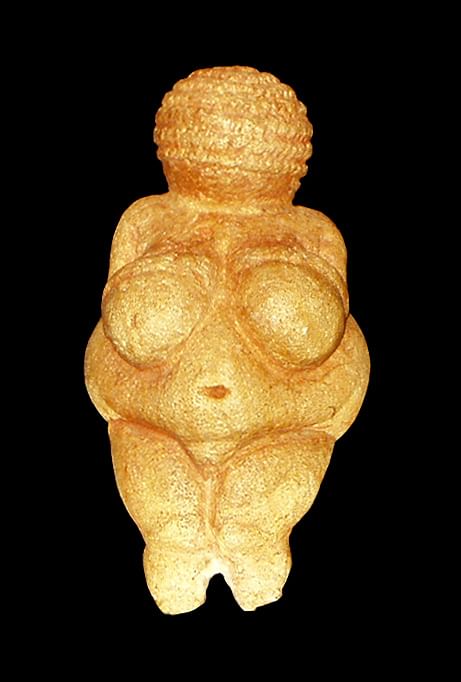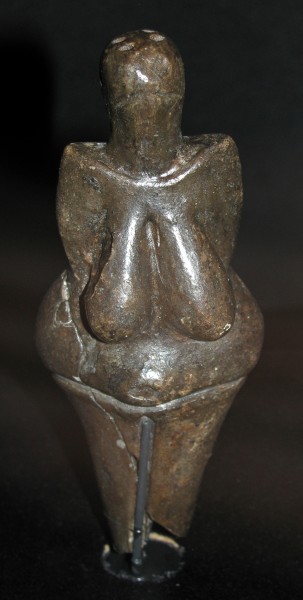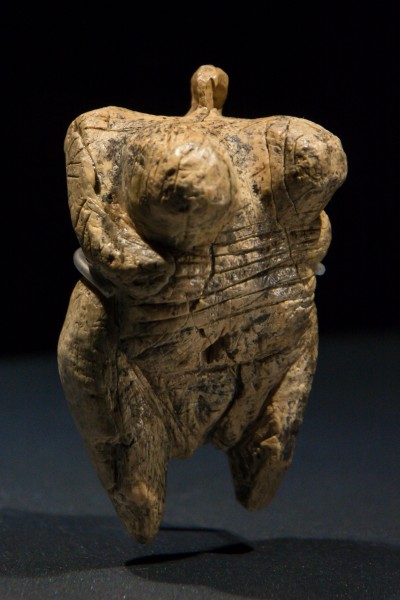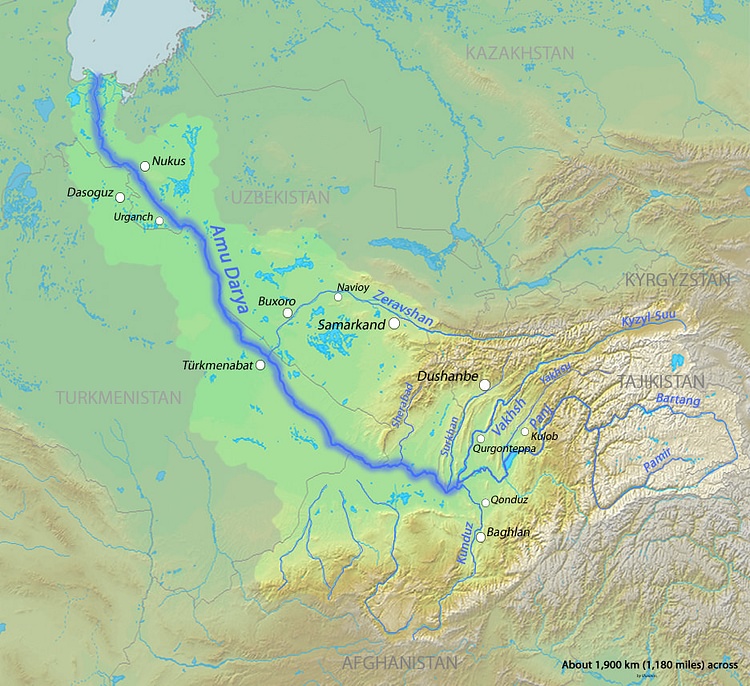Venus Figurine › Oxus » Ancient origins
Articles and Definitions › Contents
- Venus Figurine › Antique Origins
- Oxus › Ancient History
Ancient civilizations › Historical and archaeological sites
Venus Figurine › Antique Origins
Definition and Origins

The term Venus figurine is used to describe the more than 200 small statuettes of voluptuous female figures that have been found at Upper Paleolithic sites across Europe and some parts of Asia. “When paleoanthropologists refer to figurines as Venuses, [they] usually do so with air quotes” (von Petzinger, 95), because Venus figurines pre-date myths about the goddess Venus by thousands of years. The name is derived, in part, from theories that associate these figurines with fertility and sexuality, two traits associated with the Roman goddess.
CHARACTERISTICS
The so-called Venus figurines date from between about 40,000 BCE and 10,000 BCE. They are generally quite small with sizes typically ranging from 2.5 cm to 10.2 cm though a few examples as large as 24 cm have been found. The most common material used to carve these statuettes is mammoth tusk, but teeth, antlers, bone, and stone were also used. A very small number of sites produced clay figurines, which are among the earliest known examples of ceramic art. The figures are usually voluptuous female nudes. Some of their features, such as their breasts, hips, stomachs and pubic areas, are greatly exaggerated while other characteristics are absent or downplayed. It is quite common for the figurines to be faceless with poorly defined arms and legs and a silhouette that is tapered at the top and bottom. The carvings often lack defined hands and feet. Given that the creators of these carvings were separated by 30,000 years and hundreds of kilometers, it is remarkable that so many of them share the same traits.
THE MOST COMMON MATERIAL USED TO CARVE VENUS FIGURINES IS MAMMOTH TUSK.
IMPORTANT FINDS
While the majority of Venus figurines conform to these voluptuous characteristics, individual finds show that there is some diversity in terms of their materials and construction. They are also quite diverse in terms of their location. They have been found at sites all over Europe and as far afield as Siberia. Most have been found at prehistoric settlement sites, both inside caves and at open-air locations. While extremely rare, some figurines have been found in burial places.
The oldest known Venus, the Venus of Hohle Fels, was found in a cave of the same name in Schelklingen, Germany and is believed to be between 35,000 and 40,000 years old. It is carved from wooly mammoth ivory. In place of a head, the Venus of Hohle Fels has a loop, which suggests it may have been worn as a pendant. Many Venuses have perforations that suggest they may have been worn as jewelry.
One of the best known Venus figurines is the Venus of Willendorf who is named for the location where she was found in Austria. The Willendorf Venus is around 25,000 years old. She was carved from limestone, another commonly used material.

The Venus of Laussel
The Venus of Laussel is also carved from limestone and shares many of the traits of a Venus figurine while remaining unique in terms of prehistoric art. Found in France and believed to be between 18,000 and 20,000 years old, this Venus is a rare example of a prehistoric bas-relief. Like many of these figures, the Laussel Venus was once covered in red ochre, an aspect that suggests a connection with menstruation and fertility. Traces of this ochre are still visible to the naked eye. She is holding a curved horn inscribed with 13 lines that may represent lunar or menstrual cycles.
Equally unique are the ceramic Venuses at Dolni Vestonice in the Czech Republic and Vela Spila in Croatia. They are the oldest examples of kiln-fired clay artifacts yet known. At Dolni Vestonice, they developed a mixture of clay and ground bone that often produced a self-glazing finish in the kiln, causing many of the figures found at this site to have an unusual, shiny, black appearance. The Black Venus of Dolni Vestonice is the most well-known example of a figurine made with this material.While fairly unique in terms of her colour and material, the Black Venus shares the curvaceous appearance of her counterparts found throughout Eurasia.

Black Venus of Dolni Vestonice
THEORIES ABOUT THEIR PURPOSES
What intrigues many scholars is the voluptuous nature of these figurines. They were produced at a time when the average woman would have been lean and muscular. For this reason, many researchers theorize that these figures were not portraits of real women, but religious icons. Their small size, which suggests that the figures may have been held in the hands during rituals, further supports this theory. Certainly, their diminutive dimensions made it easier for our nomadic ancestors to transport these potentially sacred objects from place to place.
As the features that are exaggerated and emphasized in most of the carvings (large breasts, ample hips, protruding stomachs) are associated with fertile and pregnant women, it is possible that these female figures served as fertility symbols. Some scholars have also posited that these figurines, which often appear pregnant, may depict a mother goddess or a deity associated with childbearing. Those figurines that contain apertures that would have allowed them to be strung, like the Venus of Hohle Fels, may have been worn as amulets to protect women during pregnancy and childbirth. Some Venuses were once anointed with red ochre while others were decorated with symbols that may be associated with lunar cycles; both of these aspects suggest a connection to menstruation and fertility as well.

Venus of Hohle Fels
While the theory that Venus figurines were carved as fertility symbols or religious objects is the most commonly accepted hypothesis, many other theories have been advanced to explain the proliferation of these carvings. It has been suggested that they are dolls or portraits. Other researchers believe they may represent ideal beauty standards or serve as a kind of Paleolithic pornography. Given the vast range of time and geographic space over which these figurines were produced, it is possible that they may have had multiple meanings and served multiple purposes. In reality, we do not have enough evidence to conclusively determine which, if any, of these theories, is accurate. Like most cultural items from the Upper Paleolithic era, their true meaning may never be known.
Ultimately, in terms of Paleolithic art, Venus figurines are rare. In fact, images of humans of any kind are quite uncommon and show up much later in the timeline of prehistoric art. Humans began creating art about 80,000 years ago, but images of humans only show up between 30,000 and 40,000 years ago. At sites where multiple figurines have been found, it is rare for Venus-style statuettes to compose the majority. An equal number of animal subjects are often present, and many of the human figures are male or of ambiguous gender. Amongst all the art created by our prehistoric ancestors, images of animals were by far the most commonplace, which suggests that to early modern humans, our species was not the most dominant or important living creature on earth.
Oxus › Ancient History
Definition and Origins

The Oxus and the Iaxartes are called twin rivers, because of their same destination, almost similar trajectories and because they both are thankless rivers, naturally irrigating only very few areas through which they flow. However, like the Iaxartes, the Oxus allowed large-scale irrigation systems which was the main reason of its area's rich history.
The Oxus was the nucleus of the successive Bactrian civilizations and kingdoms. The river was the borderline between the Persian satrapy of Sogdiana northward and Bactria southward, whereas the western part belongs to nomads. Several citieswere founded here, mostly known under their Greek names, like Alexandreia Oxeiana (actual Termez).
Alexander the Great came across the river three times between 329 and 327 BC. Later, the Eastern part of the Oxus was the nucleus of the Greco-Bactrian kingdom, whereas the western part, especially the Khiva Oasis, was the land of the Parni, who later became the Parthians invading the Seleucid empire.
LICENSE:
Article based on information obtained from these sources:with permission from the Website Ancient History Encyclopedia
Content is available under License Creative Commons: Attribution-NonCommercial-ShareAlike 3.0 Unported. CC-BY-NC-SA License